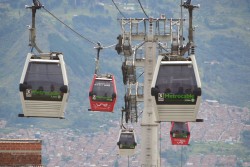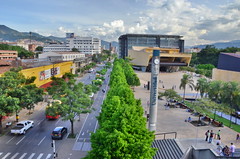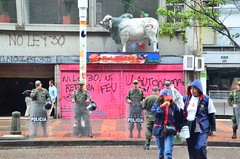
Colombia’s capital Bogota and Medellín, the modern former hub of the drug lords that once held the country hostage, couldn’t be more different. I’m nonetheless going to attempt to compare them since I love pitting apples and oranges against each other and making comparisons.
Bogotá vs. Medellín Cityscape

Plaza Bolivar in La Candelaria, Bogotá’s historical center
I’m an aesthetics person first and foremost, so we’re going to start our little comparison by analyzing the way each of these cities looks. The reader’s digest version is that while Bogotá is more visually interesting than Medellín, it’s also dirtier and more chaotic.
The tourist hub of Bogotá is La Candelaria, which also happens to be the city’s historical center. Modern Medellín lacks a historical center, but its streets are wider, its buildings are better maintained and it is generally cleaner.
Medellín is greener, more lush and significantly warmer than Bogotá. While Medellín is known as Colombia’s “spring city” for its perennial good weather, Bogotá has a typically Andean climate: Windy, cloudy and mostly cold.
Bogotá vs. Medellín Attractions

San Pedro Cemetery is one of Medellín’s most-famous tourist attractions
Bogotá and Medellín are just as different when it comes to the attractions you find in and around them as they are from an aesthetic perspective.
Aside from strolling around La Candelaria, which is an experience in and of itself, Bogotá tourists flock to Monserrate, a hill that rises approximately two miles above the city and affords a stunning panorama. Bogotá is also home to a number of highly-regarded museums, including one dedicated to famed Colombian artist Fernando Boltero.
Medellín, on other other hand, has an entire park (Parque Berrio) dedicated to the unique works of Boltero, which depict all people as fat and round. Other popular tourist attractions in Medellín include the Medellín Botanical Garden, Plaza de las Luces and San Pedro Cemetery.
Both Bogotá and Medellín provide tourists with multiple day trip opportunities, too. While the most popular excursion from Bogotá is the Salt Cathedral in the town of Zipaquira closeby, Medellín tourists flock to idyllic Guatapé and its lake.
Transportation in Bogotá vs. Medellín

Super-modern Medellín is connected by a modern metro system
Medellín has a reputation as Colombia’s most-modern city, a title that largely owes itself to a sophisticated transportation infrastructure. Medellín is home to Colombia’s only metro system and an exhaustive network of cable cars that connect to it for free. This is not only cool, but provides affordable transportation to the vast majority of the city’s residents.
Bogotá, on the other hand, has only the Transmilenio to its credit. Although its name suggests that it too is a rail network of some kind, the Bogotá Transmilenio is little more than an overcrowded bus system. The Transmilenio is popular and widely-used, but is inferior to Medellín’s metro system in every way.
The one transportation area where Bogotá beats Medellín is in terms of air transport. Although the Bogotá airport is far from “nice” and its domestic terminal is more than a mile away from its international one, it is located within the city limits of Bogotá.
The “Medellín” airport, on the other hand, sits in the town of Rio Negro. Rio Negro is more than an hour away from central Medellín, which makes taking a flight to or from Medellín extremely inconvenient.
Safety in Bogotá vs. Safety in Medellín

Riot police gear up for a workers’ protest in La Candelaria, Bogotá
I’m going to be honest: Neither Bogotá nor Medellín seemed particularly safe to me. Although I returned from Colombia having not so much as been pickpocketed, I frequently felt like my belongings (and, one or two times, my well-being) were in danger in both cities.
Indeed, Colombia is perhaps the only place in the world where the abundance of police leaves me feeling secure, rather than intimidated. This isn’t to say that Colombia’s police forces are particularly professional – they love, for example, cajoling gringos — but if they weren’t there, I would feel extremely nervous walking around both Bogotá and Medellín, even in the middle of the day.
Overall, my opinion is that no trip to Colombia is complete without visiting both Bogotá and Medellín. While busy Bogotá provides travelers with a window into Colombia’s history, Medellín is an exciting glimpse into the modern future I hope is in store for the rest of Colombia.

Robert Schrader is a travel writer and photographer who’s been roaming the world independently since 2005, writing for publications such as “CNNGo” and “Shanghaiist” along the way. His blog, Leave Your Daily Hell, provides a mix of travel advice, destination guides and personal essays covering the more esoteric aspects of life as a traveler.








